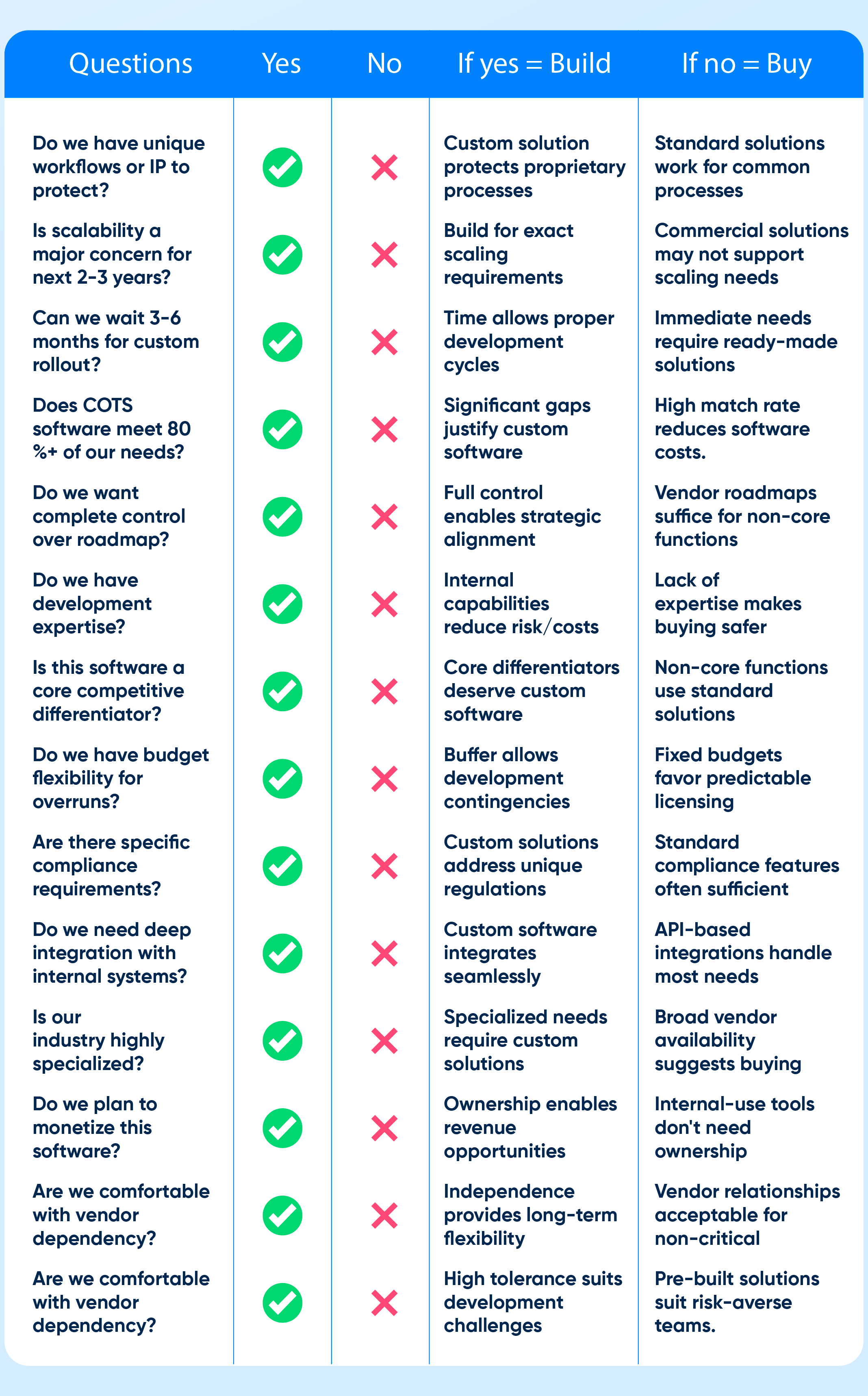You’ve identified a problem that software can solve. But now comes the million-dollar question: Is there a commercially available solution that fits just right, or will it take something tailored from the ground up to make an impact truly?
Despite extensive deliberation, this crucial question continues to capture the attention of senior decision-makers because the stakes extend beyond being a purely technical decision. One path offers better speed, predictability, and lower upfront investment. The other promises precision, control, and long-term flexibility. And the wrong move? It can result in sunk investments, disjointed workflows, and even missed opportunities.
The build vs. buy decision is not a black-and-white choice, but rather a series of trade-offs that ripple across teams, budgets, and long-term goals. It shapes team workflows, scalability, and customer experience. Clarity comes from assessing current needs and future aspirations, guiding you toward the optimal path for your business.
In the sections ahead, we unpack the build vs buy software pros and cons and the gray areas that no one tells you about, so you can make a decision with clarity. Let’s dive in.
Build vs Buy Software: Key Differences at a Glance
Before diving into frameworks and checklists, it’s essential to understand what you’re actually weighing. The “build or buy software” debate often gets boiled down to timelines and budgets, but beneath that are two fundamentally different approaches to solving business challenges through technology.
Here’s a breakdown of the difference:
Criteria | Custom Software | Commercial Software |
Initial Cost | Requires an upfront investment, including costs for a skilled development team, necessary tools, and IT infrastructure. | Typically involves a lower upfront cost, covering licensing fees and initial implementation expenses. |
Time to Market | It depends on the project complexity, encompassing planning, development, testing, and deployment. | Faster implementation and limited customization can be completed within 1 to 6 months. |
Total Cost of Ownership (5 years) | High. As it includes continuous development, infrastructure upkeep, regular updates, and dedicated support personnel. | Moderate. The overall recurring licensing, vendor support, upgrades, and potential long-term lock-ins. |
Customization Level | Fully customizable, every feature and functionality is built to match specific business needs. | Limited to customization options permitted by the vendor, which might not align fully with unique requirements. |
Control and Ownership | Offers complete control over features, product direction, data management, and release roadmap. | Limited control- feature changes, upgrades, and data policies are typically managed by the vendor. |
Scalability | Designed with specific scaling strategies in mind, adjustable to meet anticipated growth and technical demands. | May have performance or user cap limitations, often based on licensing tiers or hosted architecture. |
Integration Capabilities | Integrate seamlessly with your existing systems, offering tight alignment with internal processes. | Integration may require additional middleware or connectors, and compatibility can vary depending on the vendor. |
Buy Software Decision to Save Time and Cost
Buying commercial off-the-shelf (COTS) software often appeals because it is readily available, tested, and usually backed by a team of developers and support staff. For companies operating under tight timelines or with standard operational needs, it provides a quick fix that often “just works.”
Why Businesses Choose It?
- Go-to-market speed: Pre-built solutions can be deployed in a comparatively less time.
- Lower upfront investment: Low subscription-based pricing or one-time licenses.
Built-in support: Onboarding help, tutorials, and knowledge bases at your fingertips.
Optimal scenarios for the ‘Buy software' decision
- Startups validating their models
- Teams with generic workflows
Anyone needing a fast, low-friction rollout without deep integration demands
Build Software Decision to Meet the Exact Needs, On Your Terms
Custom software development gives you a digital solution built entirely around how your business operates. It mirrors your workflows, protects what sets you apart, and supports your team without forcing them to adapt to rigid systems.
As your business grows or shifts direction, your software grows with it, whether you’re scaling, adding new features, or integrating emerging technologies. You’re not limited by standardized tools but are equipped to build strategically, move faster, and stay in full control.
Why It’s Worth the Investment?
- Engineered to your needs: Custom software enables you to define the features, workflows, and scale to match your exact requirements without compromise.
- Scale with business: You can expand functionality and performance as you scale, without being limited by licensing or platform constraints.
Control from start to finish: You own the product, its direction, database, and every line of your code.
Optimal scenarios for the 'Build software' decision
- Businesses with unique models
- custom workflows
Long-term visions that require software to scale with the business
Build vs Buy Software Pros and Cons with a Practical Lens
We’ve already explored how each approach differs and when one might suit your business better than the other. But theory aside, what does the real-world experience of the build or buy software decision actually look like?
Let’s take a closer look at what each option brings to the table and where it might fall short. From time and cost to flexibility and long-term control, here’s how the pros and cons stack up.
Build Software: Key Pros and Cons You Need to Know
Pros | Cons |
|
|
Buy Pre-Built Software: Key Pros and Cons You Need to Know
Pros | Cons |
|
|
Build vs Buy Software: How Executive Decisions Define Long-Term Value
For executive leadership, the build or buy software decision is far more than a question of development effort or vendor selection. Because it is a high-leverage choice that directly influences ROI, operational flexibility, and long-term strategic alignment, what you decide today won’t just affect IT workflows but will shape your organization’s ability to scale, differentiate, and respond to market changes in the years ahead.
While cost analysis is essential, it is equally important to assess the broader business impact through a strategic lens. Think through these questions as you weigh your options:
- Will it grow with our business or box us in down the line?
- Can it help us truly stand out from competitors?
- Is it built to scale across markets and product lines?
- Will it fit smoothly into our current tech stack?
- What risks are we taking on, like tech debt or vendor lock-in?
- How much control do we keep over our data and roadmap?
Here’s a curated decision matrix designed for business leaders to make smarter build or buy software choices, clear, practical, and focused on what truly matters for your growth.

Decision Framework:
BUILD when 8+ YES answers, especially for unique business value, strategic control, and technical capability
BUY when 8+ NO answers, especially for standard requirements, time constraints, and resource limitations.
Final Thoughts
The build or buy software decision is a strategic lever that influences how your business captures value and adapts to change. There’s no perfect formula, but the most effective choice is one that aligns with your current business circumstances and business goals.
Whether you're optimizing for speed, control, or long-term ROI, the clarity comes from understanding what your business needs to stay competitive tomorrow. And if you're exploring a solution that’s molded to your vision, we at Squareboat specialize in building custom software that’s engineered for alignment, flexibility, and growth.
Still unsure which way to go? Book a meeting with our experts, the coffee is on us.
Frequently Asked Questions
How do I estimate the hidden costs in both build and buy decisions?
Beyond upfront budgets, hidden costs can include integration, training, maintenance, and change management. When building software, factor in team ramp-up, technical debt, and ongoing updates. When buying software, watch for rising subscription tiers, add-on features, vendor support fees, and potential re-platforming if the tool becomes limiting.
What role does internal technical capability play in the build vs buy software decision?
Your in-house tech maturity is critical. If you lack strong product management or engineering leadership, building custom software can become risky and inefficient. A buy software decision often makes more sense for teams with limited tech bandwidth or no roadmap ownership experience.
Can a hybrid approach work, where we partly build and partly buy?
Many organizations combine both: buying core platforms (like CRMs or ERPs) and building custom layers or integrations on top. This gives you speed from pre-built tools and differentiation through tailored experiences where it matters most.


